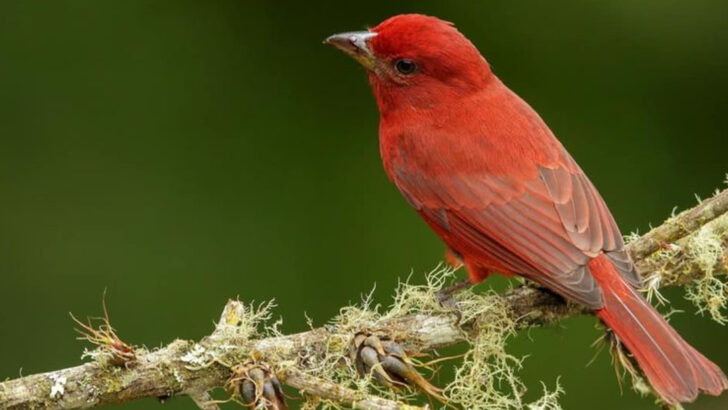Red birds are the fiery gems of any garden, bursting with color and life. Their striking feathers turn an ordinary space into something truly extraordinary, transforming your garden into a living masterpiece.
From the brilliant flashes of scarlet to the deep crimson hues, these birds don’t just stand out—they steal the show. Their beauty is a natural work of art, drawing eyes and hearts alike as they flit through the trees and across the sky.
But red birds aren’t just eye candy; they each bring their own unique character and charm to the scene. Whether they’re singing cheerful tunes or adding a playful dash of color to your garden, their presence is nothing short of magical.
Get ready to meet 16 stunning red birds that will breathe life and vibrancy into your outdoor space. Let their colorful personalities captivate you as they make your garden shine!
Northern Cardinal
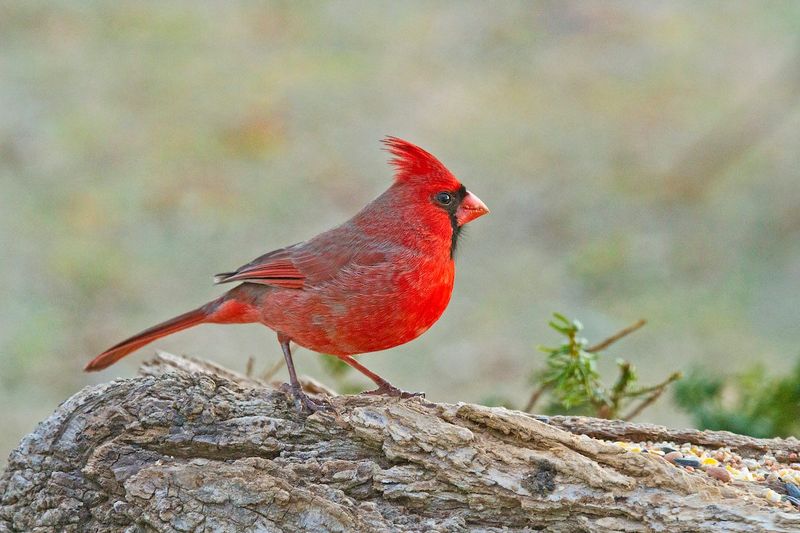
Northern Cardinals are among the most recognized birds in North America. Their bright red feathers and striking crest make them a standout. As they perch on branches, their contrasting colors against snow or greenery create a picturesque view.
Cardinals are also known to be monogamous, singing beautiful duets with their partners. They thrive in dense shrubbery, so providing a mix of trees and bushes in your garden will likely attract them.
With their cheerful presence and melodic songs, Cardinals can be both a visual delight and a calming auditory presence in your garden.
Scarlet Tanager
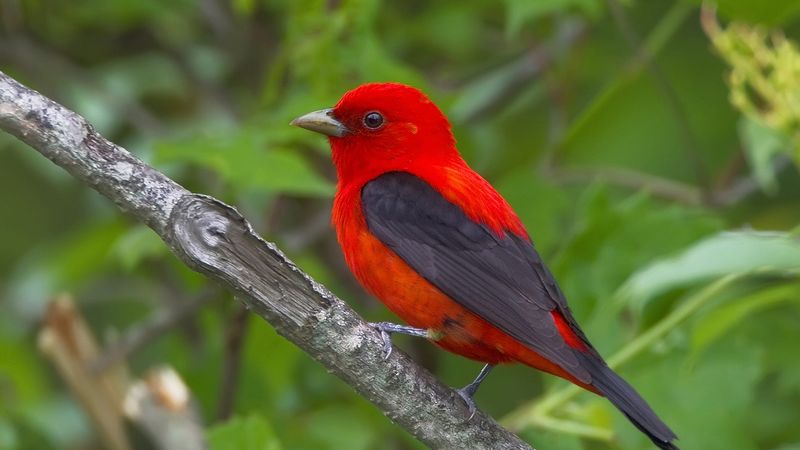
The Scarlet Tanager is a true marvel, with its bright red body and jet-black wings and tail. These birds, often found in deciduous forests, can add a splash of color to your garden.
They feed primarily on insects, so having a biodiverse garden will attract them. Their song, a series of short whistles, is a delightful addition to the morning chorus.
Though elusive, their vivid appearance when spotted among the trees is unforgettable. Encourage their presence by planting native trees and maintaining a rich insect population in your garden.
House Finch
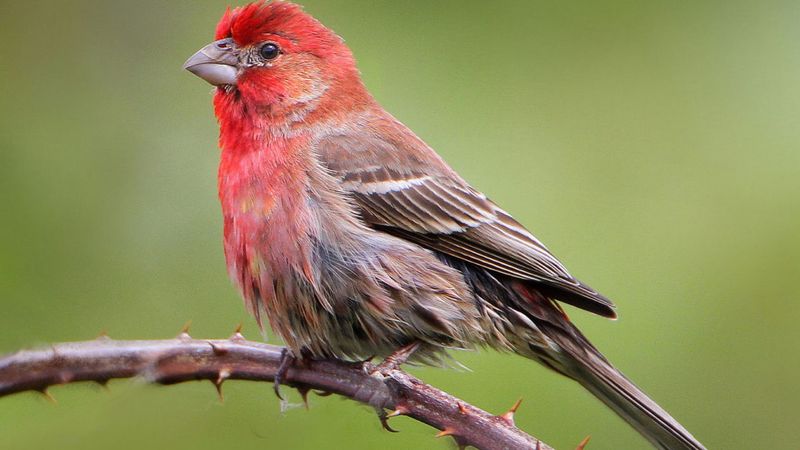
The House Finch, with its cheerful red plumage, is a common sight in urban and suburban areas. These sociable birds often travel in flocks, creating a lively atmosphere.
They are adaptive and can be attracted by offering sunflower seeds in your bird feeder. Their warbling song is cheerful and bright, echoing through gardens and parks.
House Finches are known for their ability to thrive in human-altered landscapes, making them perfect for city gardens. Their vibrant color and friendly nature often make them a favorite among bird watchers and nature enthusiasts.
Vermilion Flycatcher
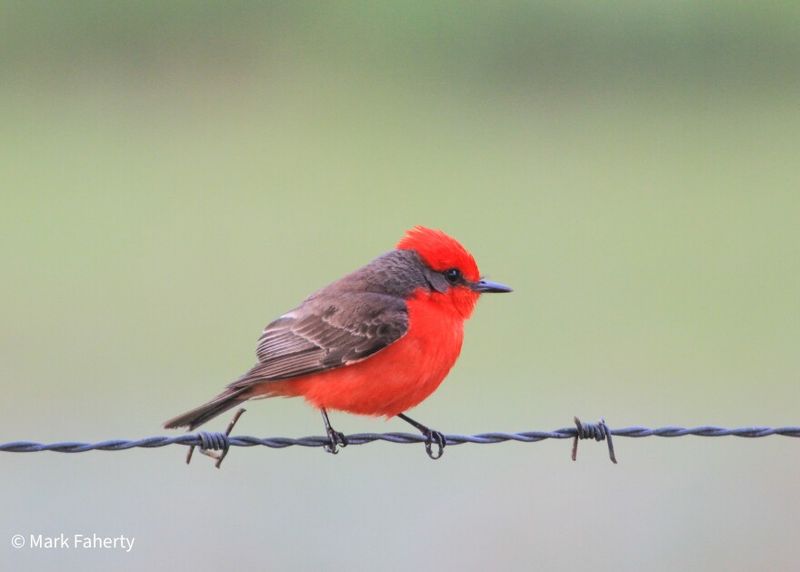
The Vermilion Flycatcher, with its vivid red plumage, is a bird of the southwestern U.S. and Mexico. Its eye-catching color stands out against the desert landscape, making it a striking visitor to any garden.
They are insectivorous, performing aerial acrobatics to catch their prey. These birds prefer open spaces with scattered trees or shrubs. By fostering an environment rich in insects, you can attract these dazzling flycatchers.
Their small size and lively behavior make them both entertaining and charming additions to your garden’s avian community.
Summer Tanager

Summer Tanagers are unique for their all-red appearance, lacking the black markings found on many other red birds. These birds are known for their love of bees and wasps, which they expertly hunt.
To attract them, consider planting fruit trees and installing a bird bath. Their soft, sweet song adds tranquility to the garden. These tanagers migrate from Central America, bringing a tropical flair to temperate gardens in the summer.
Observing their vibrant color and graceful movements can be a rewarding experience for any garden enthusiast.
Red Crossbill

The Red Crossbill’s unique bill, crossed at the tips, is specially adapted to extract seeds from conifer cones. These birds are nomadic, following cone crops across North America.
Their plumage ranges from soft orange to deep red, adding warmth to cool forest settings. To attract them, plant conifers and ensure your garden has plenty of seed-bearing trees.
Their chattering calls are a characteristic sound of coniferous forests. Their specialized feeding habits and vivid coloration make them fascinating and unusual additions to any bird-friendly garden.
Pine Grosbeak
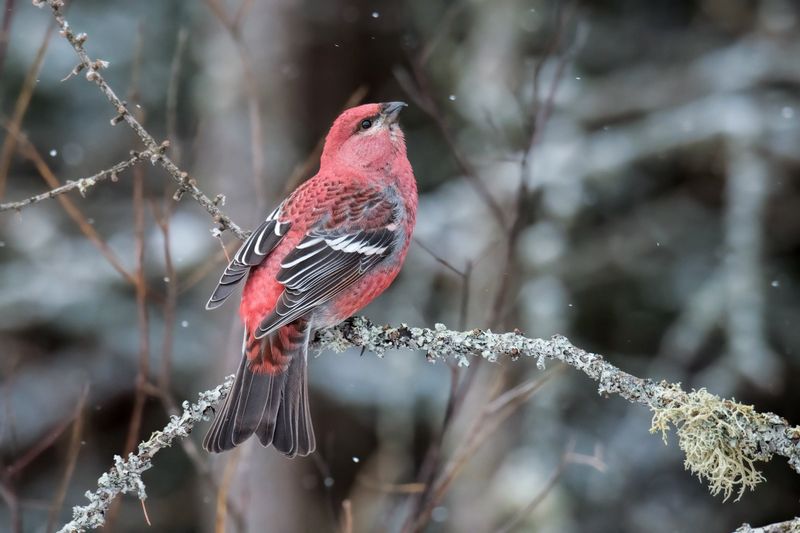
Pine Grosbeaks are gentle giants of the finch family. Males sport a rosy-red plumage that brightens up the boreal forests they inhabit. These birds have a mellow song, often heard in winter.
They feed on seeds, buds, and fruits, making them frequent visitors to feeders stocked with sunflower seeds. Their calm demeanor and slow movements make them easy to observe.
The Pine Grosbeak’s striking appearance and serene presence bring a touch of tranquility to winter gardens. They are a reminder of nature’s resilience and beauty during the colder months.
Red Avadavat

Meet the red avadavat, a charming little bird that seems to embody the spirit of a summer sunset. With its bright red body and delicate white spots, it brings a touch of exotic elegance to any setting.
Often found in open fields and wetlands, these birds are social creatures who love to gather in flocks, chattering away as they forage for seeds. Their friendly demeanor and lively antics make them a joy to observe.
To entice these delightful birds to visit your garden, try setting up a small water feature or pond. A combination of water and tall grasses can create a perfect habitat for attracting red avadavat.
Crimson Rosella
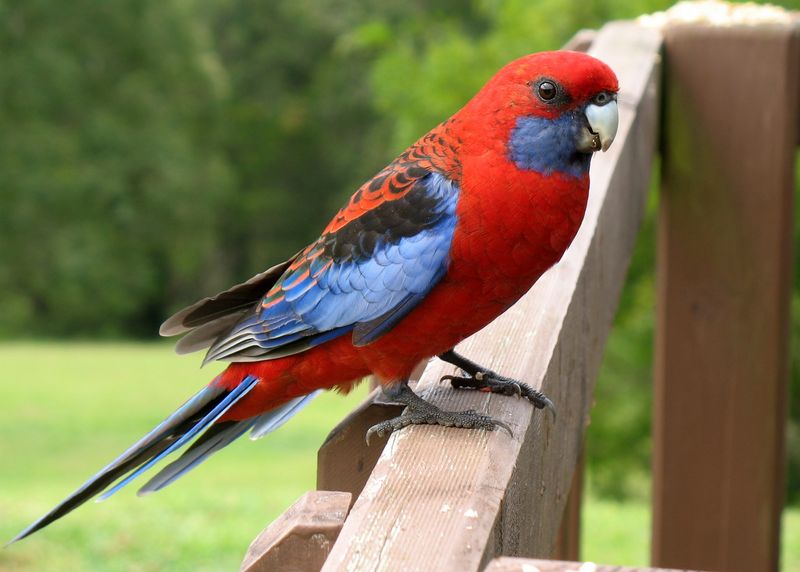
The Crimson Rosella, native to eastern and southeastern Australia, is a parrot with striking red and blue feathers. These birds are known for their playful nature and melodic whistles.
To attract them, plant native shrubs and trees where they can forage and play. Crimson Rosellas are often seen in small groups, adding a social dynamic to your garden.
Their beauty and charisma make them a favorite among bird enthusiasts. Providing a variety of native plants will not only attract these rosellas but also support other native wildlife, enriching your garden’s ecosystem.
Andean Cock-of-the-rock

In the mysterious cloud forests of the Andes, the Andean Cock-of-the-rock stands out like a living flame. With its stunning red-orange feathers and ornate crest, this bird is nothing short of a natural wonder.
Males are known for their elaborate courtship displays, where they perform a dance to impress potential mates. These birds are not only a visual treat but also a symbol of the rich biodiversity of the Andean region.
For a garden inspired by the Andean Cock-of-the-rock, incorporate elements like mossy rocks and lush, green foliage. These features can help create an enchanting environment that echoes the bird’s natural habitat.
Painted Redstart
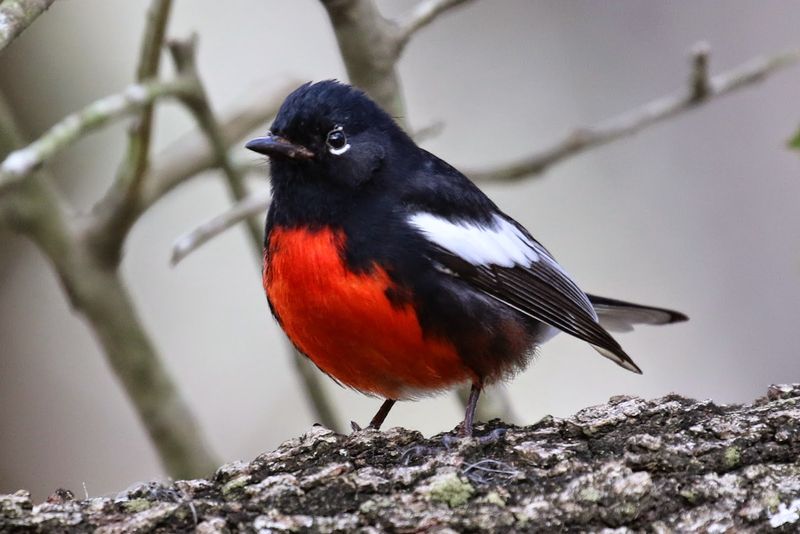
The Painted Redstart is a visual delight with a personality to match. Known for its dazzling red chest and striking black and white wings, this bird dances through the forest with grace and flair.
Their animated displays are often accompanied by a sweet melody, making them a joy for both the eyes and ears. These charming birds are curious and fearless, often exploring gardens near wooded areas.
To welcome a Painted Redstart into your garden, provide a mix of trees and shrubs to give them a place to perform their lively routines. Their spirited presence is sure to enchant any nature enthusiast.
Crimson Chat

Ever seen a bird that looks like a dot of crimson on the horizon? Meet the Crimson Chat, a small bird with striking red plumage and a cheeky black mask. These birds love open spaces and can often be found hopping energetically through the Australian outback.
Their vibrant color isn’t just for show; it plays a vital role in their courtship displays, making them a spectacle to watch. You’ll often see them flitting between bushes, their red feathers glowing in the sunlight like little embers.
If you’re planning to attract them to your garden, consider planting native bushes that mimic their natural habitat. Their inquisitive nature and social behavior make them a lovely addition to any birdwatcher’s haven.
Hepatic Tanager

The Hepatic Tanager is a striking bird of the southwestern U.S., known for its rich red color and calm demeanor. These birds prefer open woodlands and are often seen foraging in the canopy.
They have a melodious song that can make summer evenings in the garden more enchanting. Planting native shrubs and maintaining a naturalistic garden can attract them.
The Hepatic Tanager’s unique coloration and peaceful presence add a touch of southwestern charm to any outdoor space. Observing them is a delightful experience for bird enthusiasts and gardeners alike.
Crimson Sunbird
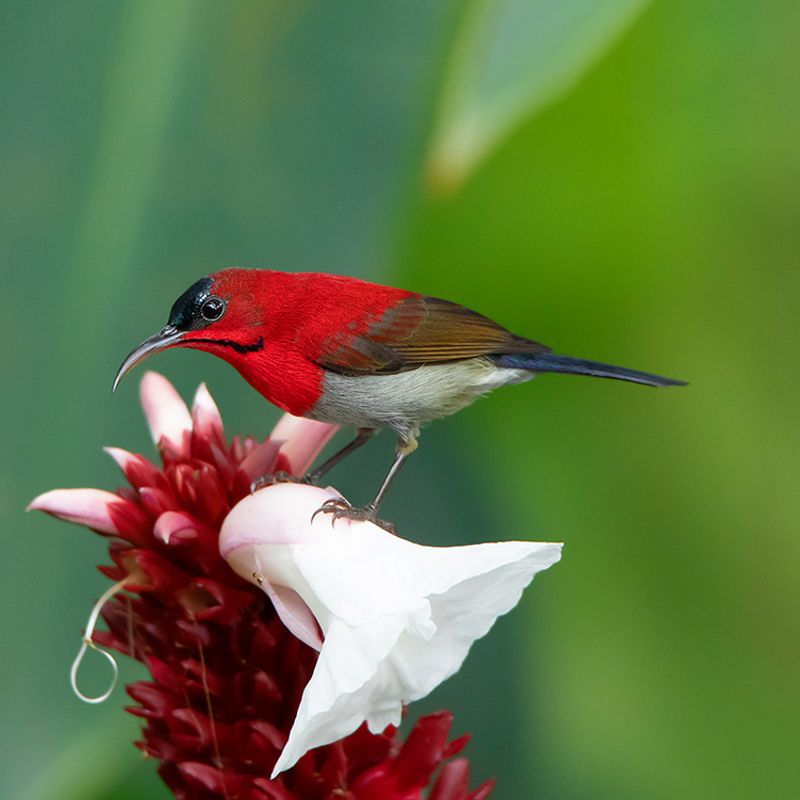
The Crimson Sunbird, with its iridescent red plumage, is a gem of Southeast Asia. These tiny birds are often seen flitting from flower to flower, sipping nectar with their slender, curved bills.
To attract them, plant nectar-rich flowers in your garden. Their metallic calls and vibrant presence make them irresistible to bird watchers.
Crimson Sunbirds are known for their rapid, darting flight, adding energy and movement to gardens. Their jewel-like appearance and dynamic feeding behavior make them a spectacular addition to tropical garden spaces.
Northern Flicker
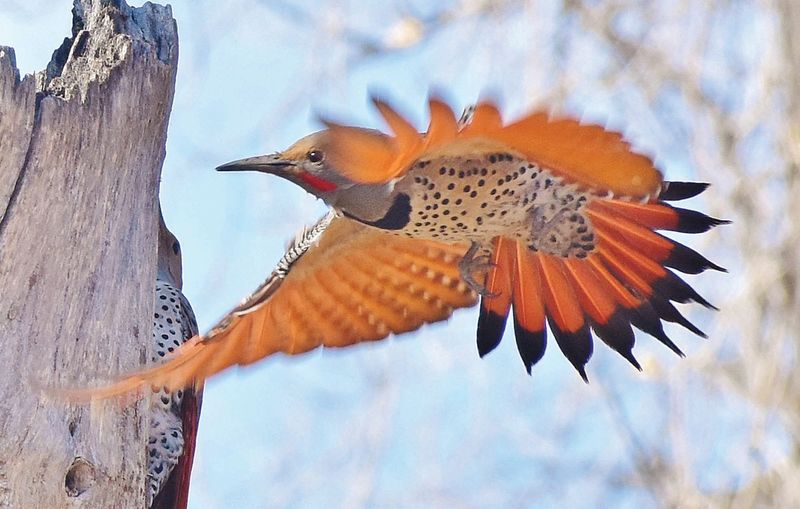
The Northern Flicker is a large woodpecker, easily identified by its spotted pattern and vibrant red shafts under the wings. These birds often forage on the ground, searching for ants and beetles.
Providing a mix of open lawns and wooded areas can attract them to your garden. Their loud, rhythmic calls are a distinctive sound of open woodlands.
Northern Flickers are known for their unique appearance and behavior, making them fascinating birds to observe. Their striking colors and active foraging habits can add character and life to any garden.
Red-headed Weaver
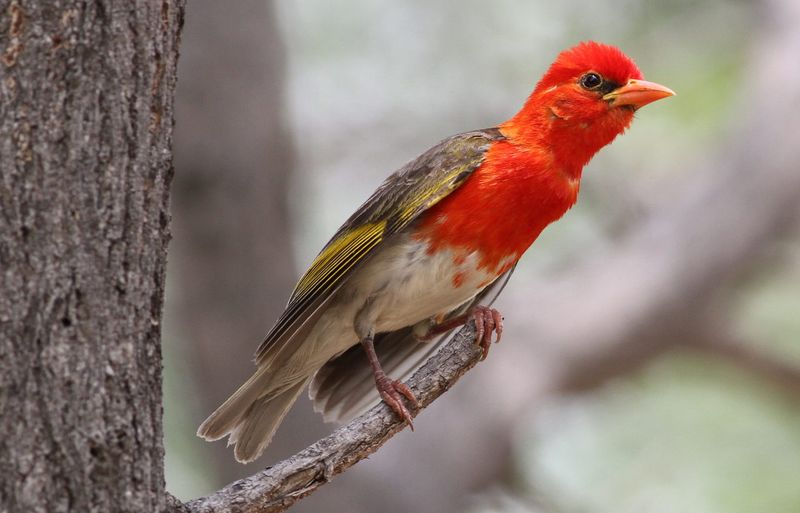
With a head as red as a ripe tomato, the Red-headed Weaver is a master builder of the avian world. These skillful architects construct elaborate nests, weaving them with precision and care in tropical settings.
Their vibrant red heads and contrasting yellow bodies make them a standout sight, especially when busy at work. You’ll often find them in pairs or small groups, chattering away as they build.
To attract these weavers, consider adding trees with long, flexible branches that they can use for their architectural marvels. Watching them at work is like witnessing nature’s very own construction team in action.

